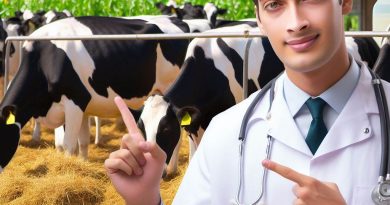Winter Care for Grazing Pastures
Last Updated on January 27, 2024
Introduction
Importance of Winter Care for Grazing Pastures
- Crucial Period: Winter demands special attention to ensure grazing pastures withstand the harsh conditions.
- Livestock Well-Being: Proper care sustains the health of grazing animals, promoting overall winter resilience.
Brief Explanation of the Topic
Winter care involves:
- Forage Preservation: Ensuring adequate winter forage availability.
- Shelter Provision: Providing shelters for livestock protection against cold weather.
- Water Management: Preventing water sources from freezing to maintain hydration.
- Monitoring Livestock: Regular checks to ensure the health and well-being of grazing animals during winter.
- Pasture Protection: Implementing strategies to prevent overgrazing and protect pasture integrity in winter conditions.
This section explores effective approaches to winter care, ensuring grazing pastures and livestock thrive throughout the colder months.
Understanding Winter Conditions
When it comes to winter care for grazing pastures, understanding the conditions that affect them is crucial.
Without proper knowledge, it becomes challenging to provide adequate care for the pastures and ensure the health of the animals.
Factors affecting grazing pastures during winter
Temperature variations
Winter brings drastic temperature changes, with freezing nights and cooler days.
These variations impact the growth and health of the grass in the pastures.
Cold temperatures decrease the metabolic activity of the plants, leading to slow growth.
Snow accumulation
Heavy snowfall can cover the grazing pastures, making it impossible for animals to access the grass.
It creates a barrier between the animals and their source of food, requiring additional measures to provide nourishment during winter.
Ice formation
Freezing temperatures can cause ice to form on the grazing pastures.
This makes it difficult for the animals to walk and feed on the grass.
It also increases the risk of injuries due to slips and falls.
Impacts of winter conditions on grazing pastures
Reduced grass growth
Due to temperature variations, the growth of grass in the pastures slows down significantly.
With limited access to sunlight and lower metabolic activity, grass growth is stunted during winter.
This affects the availability of food for the animals.
Soil compaction
During winter, the soil in grazing pastures can become compacted due to the weight of snow and ice.
The heavy load leads to compression, reducing the air and water movement in the soil.
This affects the overall soil health and nutrient availability.
Forage quality deterioration
Winter conditions can cause the forage quality in grazing pastures to deteriorate.
The cold weather and limited sunlight result in lower nutrient content in the grass.
This affects the overall nutrition provided to the animals, potentially leading to health issues.
Understanding the winter conditions that affect grazing pastures is essential for effective winter care.
By being aware of temperature variations, snow accumulation, and ice formation, appropriate measures can be taken to mitigate their impacts.
This includes providing alternative food sources, managing snow removal, and ensuring proper footing for the animals.
Moreover, being aware of the impacts of winter conditions on grazing pastures allows for proactive measures.
To combat reduced grass growth, additional feed should be provided to supplement the animals’ dietary needs.
Soil compaction can be prevented or minimized through proper pasture management practices, such as rotational grazing and using materials to enhance soil structure.
Lastly, monitoring the forage quality and providing necessary supplements can help prevent nutritional deficiencies in the animals.
This includes testing the forage for nutrient content and adjusting the feeding regimen accordingly.
Therefore, understanding winter conditions and their impacts on grazing pastures is crucial for effective winter care.
By being knowledgeable about temperature variations, snow accumulation, ice formation, reduced grass growth, soil compaction, and forage quality deterioration, appropriate measures can be taken to ensure the health and well-being of the animals throughout the winter season.
Read: Managing Drought in Grazing Lands
Preparing Grazing Pastures for Winter
Winter is a challenging season for grazing pastures, but with appropriate preparation and management, it is possible to maintain the health and productivity of these valuable resources.
In this section, we will explore essential steps to get your pastures ready for winter.
Assessing pasture health before winter
Soil testing
Before the onset of winter, it is crucial to conduct soil tests to evaluate the nutrient content, organic matter, and pH levels.
Soil deficiencies or imbalances can impact forage quality and growth.
Use reliable laboratories to analyze soil samples and provide the necessary amendments to optimize soil health.
Weed inspection
Weed infestations can reduce forage quality, compete with desirable plants, and increase the risk of toxic plant consumption by grazing livestock.
Take the time to inspect your pastures for any invasive weed species and develop a weed management plan to control and eradicate them effectively.
Addressing drainage issues
Proper pasture drainage is essential in preventing waterlogging and soil erosion, especially during wet winter months.
Inspect your pastures for any signs of poor drainage, such as standing water or overly saturated soil. Identify and rectify drainage problems by improving surface or subsurface drainage systems.
Rotational grazing management
Leaving adequate residual vegetation
To ensure healthy pasture regrowth in spring, avoid grazing too heavily in late fall before winter sets in.
Leaving an adequate residual vegetation height helps protect the soil from erosion and assists in quicker recovery during the growing season.
Monitor forage availability and adjust grazing intensity accordingly.
Avoiding overgrazing
Proper grazing management is crucial to maintain the health and productivity of your pastures.
Implement rotational grazing techniques, moving livestock from one grazing area to another, allowing forage regrowth in previously grazed areas.
This practice helps prevent overgrazing, promotes even forage utilization, and maximizes pasture productivity.
Fencing repairs and maintenance
Inspect your pasture fences for any damages or weak spots that may compromise animal containment during the winter months.
Repair or replace broken posts, tighten loose wires, and check electric fencing systems to ensure they are functioning effectively.
Well-maintained fences contribute to successful grazing management and animal welfare.
Most importantly, preparing grazing pastures for winter involves assessing pasture health, implementing rotational grazing management, and maintaining necessary infrastructure.
By following these steps, you can ensure the optimal condition of your pastures and maximize forage productivity throughout the winter season.
Winter care for grazing pastures is essential for the well-being of your livestock and the long-term sustainability of your farming operation.
Read: Livestock Feeding: Pasture vs. Supplements

Winter Grazing Strategies
During winter months, grazing pastures require special care to ensure the health and well-being of livestock.
Implementing effective winter grazing strategies can help maintain the condition of the pastures and ensure proper nutrition for the animals.
Limit grazing periods
Limiting grazing periods is essential to preserve the grass’s ability to regrow.
Extended grazing can result in overgrazing, damaging the grass and hindering its ability to recover.
Shorter grazing periods allow for recovery and regrowth.
Overgrazing can also negatively impact soil health.
By limiting grazing periods, the soil can regain its nutrient levels and prevent degradation.
Healthy soil leads to better pasture quality and availability of nutrients for livestock.
Supplementary feeding
Supplementary feeding is crucial during winter when grass may not provide sufficient nutrition.
Determining the nutrient requirements of the livestock is important to supplement their diet adequately.
Consult a veterinarian or an animal nutritionist to determine the specific needs.
Selecting appropriate feed types based on the animals’ requirements is essential.
Consider factors such as energy density, protein levels, fiber content, and mineral and vitamin composition when choosing supplementary feeds.
This ensures the animals receive balanced nutrition to maintain their health.
Providing shelter for livestock
Providing adequate shelter is vital to protect livestock from harsh winter conditions.
Temporary shelters such as portable barns or windbreaks can provide much-needed protection from snow, wind, and low temperatures.
These shelters should be strategically placed to maximize cover and minimize exposure to harsh weather.
Adequate ventilation is also crucial in livestock shelters.
Proper airflow prevents moisture buildup and reduces the risk of respiratory diseases.
Design shelters with windows or vents that allow fresh air circulation while protecting animals from drafts.
Implementing winter grazing strategies ensures the health and productivity of both pastures and livestock.
Limiting grazing periods and allowing grass to recover promotes its regrowth and maintains soil health.
Supplementary feeding meets the animals’ nutrient requirements, and providing shelters protects livestock from winter elements.
Remember, good management practices enhance the sustainability and resilience of grazing pastures, leading to healthier livestock and more productive grazing land.
Adopting these strategies will contribute to the overall success of winter pasture management.
Read: Soil Testing: Key to Pasture Success
Monitoring and Maintenance
Regular pasture inspections during winter will ensure the well-being and health of your grazing pastures.
Regular pasture inspections during winter
- Schedule regular inspections to assess the condition of the grazing pastures.
- Look for signs of overgrazing, soil erosion, or any other issues that may affect the pasture’s health.
- Keep an eye out for standing water or areas prone to flooding, as they can lead to pasture degradation.
- Evaluate the amount and quality of forage available to the livestock, making any necessary adjustments.
Managing manure and mud
- Implement a manure management plan to prevent excess accumulation and potential nutrient runoff.
- Regularly remove manure from pastures to reduce the risk of parasites and maintain pasture quality.
- Consider constructing designated heavy-use areas to minimize mud and protect grazing areas.
- Install proper drainage systems or diverters to prevent waterlogging or excessive mud accumulations.
Addressing any signs of pasture degradation
- Detect any signs of pasture degradation such as bare spots, weed invasion, or poor forage quality.
- Identify the underlying causes of degradation, such as overgrazing, soil compaction, or improper maintenance.
- Implement appropriate measures to address the specific issues identified and restore the pasture’s health.
- Consider reseeding or overseeding damaged areas to promote healthy regrowth of desirable forage.
By actively monitoring and maintaining your grazing pastures during winter, you can optimize their productivity and longevity.
Remember that prevention is key, so schedule regular inspections to promptly address any potential issues.
Remove manure regularly to maintain pasture quality and prevent parasite infestations.
Handle signs of degradation promptly to prevent further deterioration and implement remedial measures accordingly.
Seed damaged areas to promote the growth of nutritious forage.
In essence, proactive monitoring, effective manure management, and prompt action in response to pasture degradation signs are essential for the winter care of grazing pastures.
By implementing these practices, you can ensure the well-being of your livestock and the productivity of your pastures.
Read: Grazing Plans for Small Farms
Transitioning to Spring
Assessing pasture conditions
During the transition from winter to spring, it is crucial to assess the condition of your grazing pastures.
This assessment will help you understand what steps need to be taken to ensure the health and productivity of the pastures.
- Walk through the pastures and inspect the grass for signs of growth and health.
- Look out for areas with sparse vegetation or obvious signs of damage.
- Take note of any areas that may have been overgrazed during the winter months.
- Assess the overall quality of the soil, looking for signs of compaction or erosion.
Soil testing to determine necessary amendments
Once you have assessed the condition of your pastures, it is essential to conduct soil testing.
This will provide valuable information about the nutrient content of the soil and any necessary amendments that need to be made.
- Collect soil samples from different areas of the pastures to ensure representative results.
- Follow the instructions provided by your local agricultural extension office or soil testing lab for proper sample collection.
- Send the soil samples to a trusted lab for analysis.
- The results will provide insights into the pH level, nutrient deficiencies, and excesses in the soil.
- Based on the results, make informed decisions regarding the application of fertilizers or soil amendments.
Developing a pasture management plan for spring
After assessing pasture conditions and receiving soil test results, it is time to develop a comprehensive pasture management plan for the spring season.
- Determine the appropriate grazing rotation system based on the size of your pastures and the number of livestock.
- Divide the pastures into smaller paddocks to allow for rotational grazing.
- Establish a schedule for moving livestock between paddocks to prevent overgrazing.
- Consider implementing a rest period for some areas to promote grass regrowth and sustainability.
- Utilize the soil test results to develop a fertilizer and amendment application plan.
- Calculate the appropriate amount of nutrients and amendments needed to optimize pasture growth.
- Keep track of the dates and quantities of any applications made to the pastures.
- Monitor the condition of the pastures throughout the spring, making adjustments to the management plan as necessary.
- Regularly observe the livestock grazing behavior to ensure they have adequate access to fresh forage.
- Implement measures to control weeds, pests, and diseases that may impact the health of the pastures.
By assessing pasture conditions, conducting soil testing, and developing a pasture management plan, you can ensure the transition to spring is smooth for your grazing pastures.
Take proactive measures to promote healthy grass growth and provide ample nutrition for your livestock.
Conclusion
Recap of key points
During the winter, it is essential for farmers to prioritize the care of their grazing pastures.
Monitoring the pasture’s condition, providing adequate shelter and nutrition, and implementing rotation systems are crucial to maintain its health and productivity.
Encouragement for farmers to prioritize winter care for grazing pastures
By prioritizing winter care for grazing pastures, farmers can ensure the long-term health and productivity of their livestock and reduce costs related to veterinary care and feed supplements.
Carefully managing the pasture during winter also benefits the environment and surrounding ecosystem, promoting soil fertility and preventing erosion.
Closing remarks
Winter care for grazing pastures is not an option but a necessity for farmers.
By implementing proper strategies and maintaining a proactive approach, farmers can maximize the potential of their pastures and provide optimal conditions for their livestock, even during the cold season.
Investing time and effort into winter care will lead to better overall farm management and the success of the agricultural operation.


